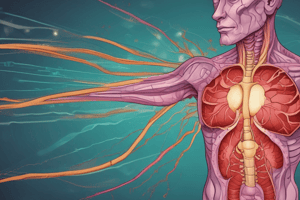Podcast
Questions and Answers
What is the typical size of the thyroid gland?
What is the typical size of the thyroid gland?
- 4-5cm across
- 5-6cm across
- 1-2cm across
- 2-3cm across (correct)
Which of the following arteries supplies blood to the thyroid gland?
Which of the following arteries supplies blood to the thyroid gland?
- Thyrocervical trunk
- External carotid artery (correct)
- Internal carotid artery
- Subclavian artery
What is the primary mechanism by which the levels of thyroid hormone are controlled in the body?
What is the primary mechanism by which the levels of thyroid hormone are controlled in the body?
- Feedforward mechanism
- Negative feedback loop (correct)
- Open-loop system
- Positive feedback loop
What is the primary function of thyroid-stimulating hormone (TSH) in the body?
What is the primary function of thyroid-stimulating hormone (TSH) in the body?
What is the primary function of thyroxine-binding globulin (TBG) in the body?
What is the primary function of thyroxine-binding globulin (TBG) in the body?
What is the response of the hypothalamus to decreased peripheral thyroid hormone levels?
What is the response of the hypothalamus to decreased peripheral thyroid hormone levels?
Flashcards are hidden until you start studying
Study Notes
Thyroid Gland Anatomy
- Located anterior to the trachea and inferior to the larynx
- Shaped like a butterfly (bow-tie) with two lateral lobes joined by a central isthmus
- Typically 2-3cm across and weighs around 15-20g
- Highly vascularized, receiving blood from superior and inferior thyroid arteries
- Drained via superior, middle, and inferior thyroid veins
Thyroid Hormone Regulation
- Regulated through the hypothalamic-pituitary-thyroid (HPT) axis
- Decreased peripheral thyroid hormone levels stimulate the hypothalamus to produce thyroid-releasing hormone (TRH)
- TRH stimulates the anterior pituitary to produce thyroid-stimulating hormone (TSH)
- TSH increases iodine uptake and release of triiodothyronine (T3) and thyroxine (T4) in the thyroid gland
- Circulating thyroid hormone levels are controlled through negative feedback on the hypothalamus and pituitary
Thyroid Hormone Transportation
- T3 and T4 are hydrophobic molecules transported in the blood reversibly bound to carrier proteins
- Carrier proteins include thyroxine-binding globulin (TBG), transthyretin (TTR, or prealbumin), and albumin
- Only a small amount of T3 and T4 is free and unbound in the blood
Studying That Suits You
Use AI to generate personalized quizzes and flashcards to suit your learning preferences.




